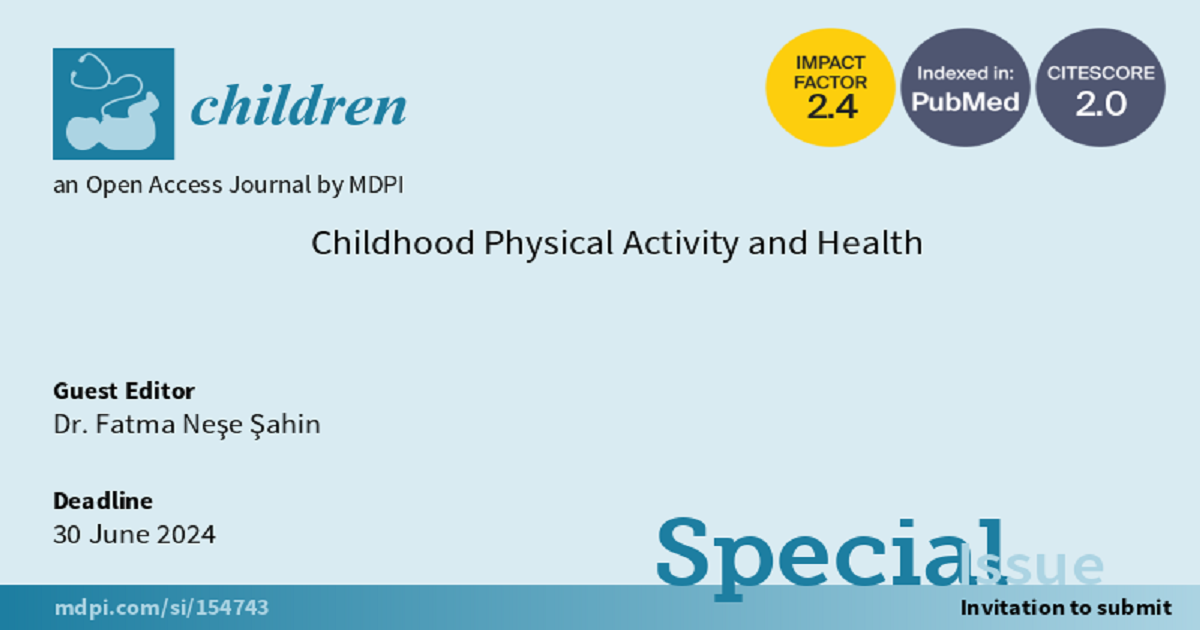- 2.1Impact Factor
- 3.8CiteScore
- 16 daysTime to First Decision
Childhood Physical Activity and Health
This special issue belongs to the section “Global Pediatric Health“.
Special Issue Information
Dear Colleagues,
We are editing a Special Issue for the journal Children focusing on the role of physical activity and health in childhood to advance the state of knowledge through a collection of articles. It is a well-established fact that physical activity plays a crucial role in supporting and promoting children’s physical, mental, and social health. Therefore, physical activity and health are considered two major concepts to address in the child population. It is well known that in recent years, the sedentary lifestyle of children has increased due to technological advancements and the COVID-19 Pandemic. A sedentary lifestyle can threaten the motor skill development and health of children in the future. By contrast, different physical activities can have positive effects on children's health. Physical activity can increase the physical fitness levels of children, plays an important role in biomotor development, and also reflects positively on school performance. Thus, physical activity practices are an excellent tool for promoting health. However, more research and data are needed to determine the right exercises for children to be healthier. This Special Issue aims to provide new insights into the effects and health benefits of physical exercise in children. For these purposes, we welcome you to submit different types of articles, primarily original research articles.
Dr. Fatma Neşe Şahin
Guest Editor
Manuscript Submission Information
Manuscripts should be submitted online at www.mdpi.com by registering and logging in to this website. Once you are registered, click here to go to the submission form. Manuscripts can be submitted until the deadline. All submissions that pass pre-check are peer-reviewed. Accepted papers will be published continuously in the journal (as soon as accepted) and will be listed together on the special issue website. Research articles, review articles as well as short communications are invited. For planned papers, a title and short abstract (about 250 words) can be sent to the Editorial Office for assessment.
Submitted manuscripts should not have been published previously, nor be under consideration for publication elsewhere (except conference proceedings papers). All manuscripts are thoroughly refereed through a single-blind peer-review process. A guide for authors and other relevant information for submission of manuscripts is available on the Instructions for Authors page. Children is an international peer-reviewed open access monthly journal published by MDPI.
Please visit the Instructions for Authors page before submitting a manuscript. The Article Processing Charge (APC) for publication in this open access journal is 2400 CHF (Swiss Francs). Submitted papers should be well formatted and use good English. Authors may use MDPI's English editing service prior to publication or during author revisions.
Keywords
- childhood
- physical activity (physical exercise)
- movement training
- children’s health
- motor skills

Benefits of Publishing in a Special Issue
- Ease of navigation: Grouping papers by topic helps scholars navigate broad scope journals more efficiently.
- Greater discoverability: Special Issues support the reach and impact of scientific research. Articles in Special Issues are more discoverable and cited more frequently.
- Expansion of research network: Special Issues facilitate connections among authors, fostering scientific collaborations.
- External promotion: Articles in Special Issues are often promoted through the journal's social media, increasing their visibility.
- e-Book format: Special Issues with more than 10 articles can be published as dedicated e-books, ensuring wide and rapid dissemination.

